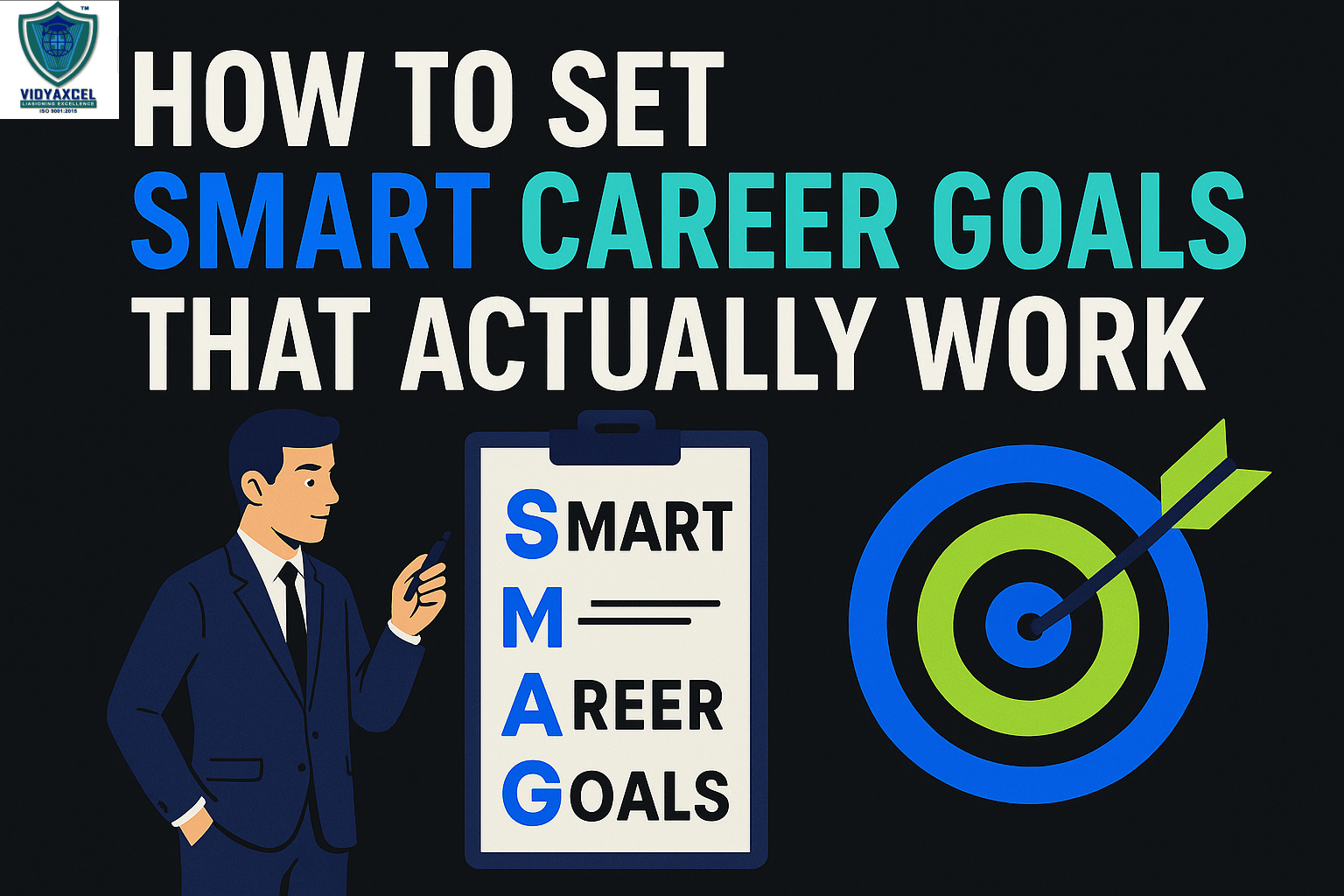Blog Details

06Jun
How to Set SMART Career Goals That Actually Work
Career goals represent your vision for the future. They provide clarity about where you want to go professionally—whether that’s achieving a promotion, changing careers, acquiring new skills, or starting your own business. But the key to success isn’t just about having goals—it’s about having the right kind of goals.
Why Goal Setting Matters
Goal setting helps in:
- Motivation: Gives a reason to push forward.
- Direction: Clarifies your path in an otherwise ambiguous journey.
- Focus: Filters out distractions and keeps you on track.
- Decision-Making: Provides criteria to evaluate choices.
- Measurement of Progress: Enables self-assessment and course correction.
Without clear goals, effort may be wasted, and opportunities may pass unnoticed.
What Are SMART Goals?
SMART is an acronym that stands for:
- S – Specific
- M – Measurable
- A – Achievable
- R – Relevant
- T – Time-Bound
This framework ensures that your goals are clear, realistic, and structured in a way that sets you up for success.
Breaking Down SMART
Specific
Your goal should clearly state what you want to accomplish. The more specific, the better.
Bad Example: “I want to be successful.”
SMART Example: “I want to become a senior software engineer at a tech company like Google or Amazon.”
Ask yourself:
- What do I want to accomplish?
- Why is this goal important?
- Who is involved?
- Where is it located?
- Which resources or limits are involved?
Measurable
If you can’t measure it, you can’t manage it. This part helps you track progress and stay motivated.
Bad Example: “I want to improve my skills.”
SMART Example: “I want to complete a data analytics certification and get at least 85% in the final exam.”
Ask yourself:
- How much?
- How many?
- How will I know when it is accomplished?
Achievable
Set a goal that is challenging but realistic based on your current resources and constraints.
Bad Example: “I want to be a CEO in a year.”
SMART Example: “I want to get promoted to team lead in the next performance cycle.”
Ask yourself:
- How can I accomplish this goal?
- Is the goal reasonable given my current skills and circumstances?
Relevant
The goal should align with your broader career and life plans.
Bad Example: “I want to become a fashion designer” (when you’re studying finance and have no passion for fashion).
SMART Example: “I want to pursue an MBA in finance because I aim to become an investment analyst.”
Ask yourself:
- Does this goal matter to me?
- Is it the right time?
- Does it align with my long-term objectives?
Time-Bound
A deadline creates urgency and prompts action.
Bad Example: “I want to write a book someday.”
SMART Example: “I want to finish the first draft of my career advice book in 6 months.”
Ask yourself:
- When?
- What can I do today/next week/next month?
- What is the deadline?
How to Set SMART Career Goals: A Step-by-Step Guide
Step 1: Self-Assessment
Before setting goals, know yourself:
- What are your interests?
- What are your strengths and weaknesses?
- What values matter most to you?
Use tools like SWOT analysis, personality tests (MBTI), and career interest inventories.
Step 2: Research Career Options
Explore industries, job roles, and growth opportunities. Use platforms like:
- Glassdoor
- Career Explorer
- Government employment sites
Step 3: Identify Long-Term Goals
These are goals you want to achieve in the next 5–10 years. Examples:
- Become a department head
- Start a successful consultancy firm
Step 4: Break Down into Short-Term Goals
Divide long-term goals into actionable steps:
- Complete relevant certifications
- Attend networking events
- Build a portfolio or resume
Step 5: Apply the SMART Framework
Rewrite your goals to ensure they meet all SMART criteria. Write them down, say them aloud, and make them visible.
Step 6: Make an Action Plan
List:
- Resources needed (courses, mentorship, time)
- Potential obstacles
- Backup strategies
Step 7: Monitor and Evaluate
Set regular check-ins (monthly/quarterly) to assess progress and make adjustments.
Examples of SMART Career Goals
For Students
“I want to complete an internship in a marketing firm for at least 3 months before the end of this academic year.”
For Working Professionals
“I want to get a PMP certification by December to qualify for project management roles in my company.”
For Career Switchers
“I want to transition into UX design by completing a bootcamp and building a portfolio within the next 6 months.”
For Entrepreneurs
“I want to launch my online business and achieve ₹50,000/month in revenue within the first year.”
SMART Goals for Different Stages of Career
|
Stage |
Goal Example |
|
High School Student |
"I want to shadow 2 professionals in careers I’m interested in before applying to colleges." |
|
College Student |
"I want to publish one research paper by the time I graduate." |
|
Entry-Level Professional |
"I aim to earn a promotion within 1.5 years by improving team collaboration and project delivery." |
|
Mid-Career Professional |
"I want to shift into a leadership role within 2 years by completing an executive education course." |
|
Senior Professional |
"I want to mentor 3 young professionals this year to contribute to talent development." |
Common Mistakes to Avoid
- Being too vague: “Get a good job” is not actionable.
- Setting unrealistic timelines: Overambitious goals can lead to burnout.
- Not aligning goals with passions: Leads to loss of interest and commitment.
- Ignoring setbacks: Be flexible; career paths aren’t linear.
- Failing to track progress: You won’t know how close you are to success.
Tools and Resources to Track SMART Goals
- Digital Planners: Notion, Trello, Click Up
- Goal Tracking Apps: Goals OnTrack, Strides, Habita
- Career Development Platforms: Coursera, Udemy, LinkedIn Learning
- Spreadsheets: Create a personalized goal sheet with deadlines and status columns.
Role of Parents and Mentors in Goal Setting
For Parents:
- Encourage exploration and curiosity.
- Avoid imposing outdated aspirations.
- Focus on the child’s strengths and interests.
- Provide emotional and financial support when needed.
For Mentors:
- Offer honest feedback and industry insights.
- Help mentees articulate and refine their goals.
- Encourage realistic expectations and celebrate small wins.
- Provide networking opportunities and accountability.
Conclusion
SMART career goals aren’t just a motivational tool—they are a blueprint for personal and professional growth. By making your goals Specific, Measurable, Achievable, Relevant, and Time-bound, you greatly increase your chances of turning aspirations into accomplishments.
Whether you're helping your child set direction or planning your own next move, SMART goals empower you to take control of the journey with clarity and confidence.
FAQs
Q1: How often should I revise my SMART career goals?
Answer: Ideally, revisit your goals every 3–6 months or after major life changes (job switch, relocation, etc.).
Q2: What if my interests change after setting SMART goals?
Answer: That’s normal. SMART goals are flexible—revise them to match your evolving aspirations.
Q3: Are SMART goals useful for creative careers like writing or art?
Answer: Absolutely. Example: “I want to complete and publish 12 blog posts in the next 3 months.”
Q4: Can teenagers set SMART career goals?
Answer: Yes. They can set small, exploratory goals like attending a career fair or researching a field.
Q5: What’s the first step to get started with SMART career goals?
Answer: Begin with self-assessment. Understand your values, skills, and interests before creating structured goals.
Our Office: West Bengal, Maharashtra & Delhi.
For More Infomation about admission in Medical, Engineering, Management & Study in Overseas Details.
View Current Study Overseas, Medical, Engineering & Management Admission Details Video.




